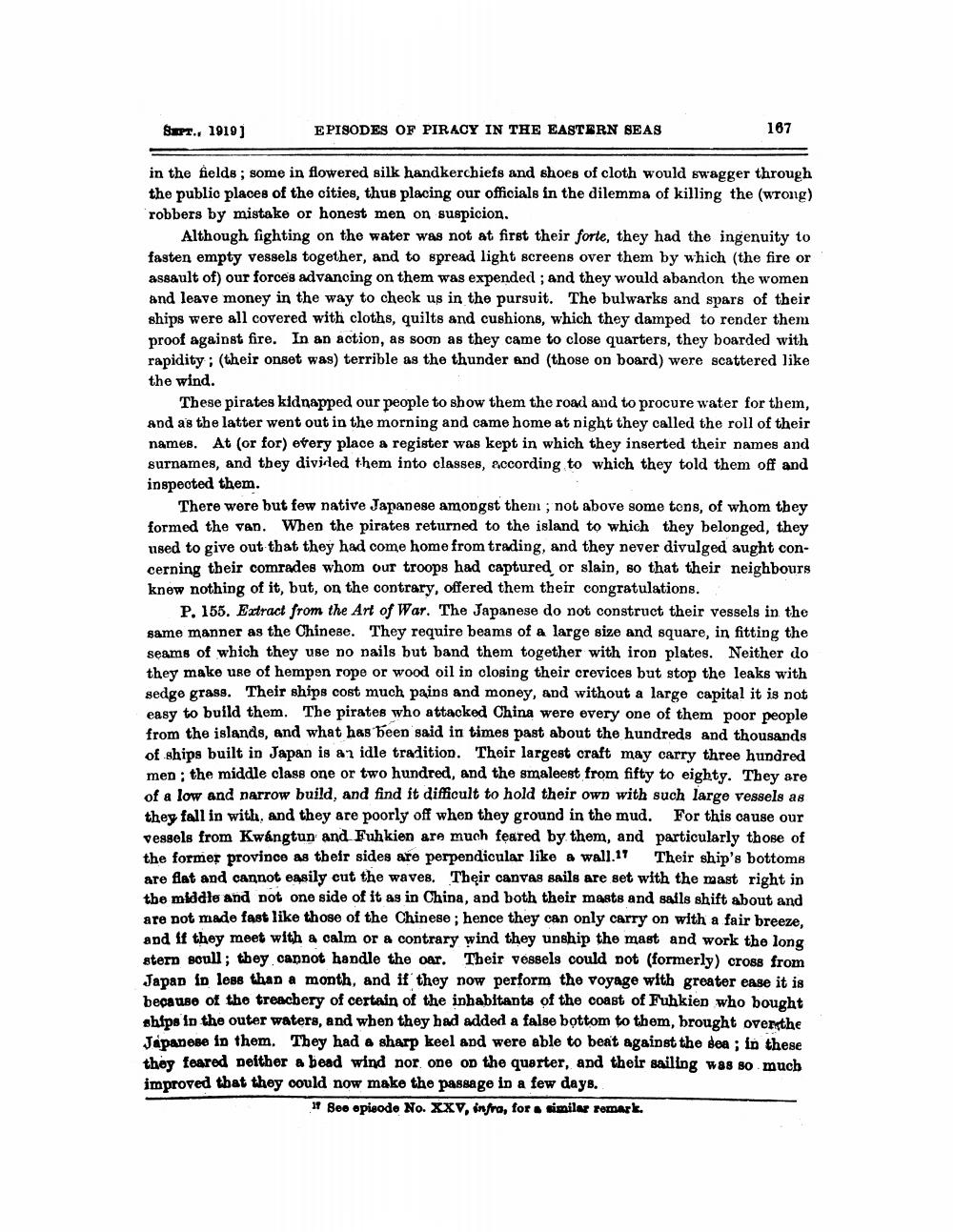________________
Sept., 1919)
EPISODES OF PIRACY IN THE EASTERN SEAS
167
in the fields ; some in flowered silk handkerchiefs and shoes of cloth would swagger through the public places of the cities, thus placing our officials in the dilemma of killing the (wrong) robbers by mistake or honest men on suspicion.
Although fighting on the water was not at first their forte, they had the ingenuity to fasten empty vessels together, and to spread light screens over them by which the fire or assault of) our forces advancing on them was expended ; and they would abandon the women and leave money in the way to check us in the pursuit. The bulwarks and spars of their ships were all covered with cloths, quilts and cushions, which they damped to render them proof against fire. In an action, as soon as they came to close quarters, they boarded with rapidity: (their onset was) terrible as the thunder and those on board) were scattered like the wind.
These pirates kidnapped our people to show them the road and to procure water for them, and as the latter went out in the morning and came home at night they called the roll of their names. At (or for) every place a register was kept in which they inserted their names and surnames, and they divided them into classes, according to which they told them off and inspeoted them.
There were but few native Japanese amongst them; not above some tons, of whom they formed the van. When the pirates returned to the island to which they belonged, they used to give out that they had come home from trading, and they never divulged aught concerning their comrades whom our troops had captured, or slain, so that their neighbours knew nothing of it, but, on the contrary, offered them their congratulations.
P. 155. Extract from the Art of War. The Japanese do not construct their vessels in the same manner as the Chinese. They require beams of a large size and square, in fitting the seams of which they use no nails but band them together with iron plates. Neither do they make use of hempen rope or wood oil in closing their crevices but stop the leaks with sedge grass. Their ships cost much pains and money, and without a large capital it is not easy to build them. The pirates who attacked China were every one of them poor people from the islands, and what has been said in times past about the hundreds and thousands of ships built in Japan is an idle tradition. Their largest craft may carry three hundred men; the middle class one or two hundred, and the smaleest from fifty to eighty. They are of a low and narrow build, and find it difficult to hold their own with such large vessels as they fall in with, and they are poorly off when they ground in the mud. For this cause our vessels from Kwángtun and Fuhkien are much feared by them, and particularly those of the former province as their sides are perpendicular like a wall.17 Their ship's bottoms are flat and cannot easily cut the waves. Their canvas sails are set with the mast right in the middle and not one side of it as in China, and both their masts and sails shift about and are not made fast like those of the Chinese ; hence they can only carry on with a fair breeze, and if they meet with a calm or a contrary wind they unship the mast and work the long stern soull; they cannot handle the oar. Their vessels could not (formerly) cross from Japan in less than a month, and if they now perform the voyage with greater ease it is because of the treachery of certain of the inhabitants of the coast of Fuhkien who bought ships in the outer waters, and when they had added a false bottom to them, brought over the Japanese in them. They had a sharp keel and were able to beat against the sea ; in these they feared Deither a bead wind nor one on the quarter, and their sailing was so much improved that they could now make the passage in a few days.
1 Bee opisode No. XXV, infra, for similar remark.




